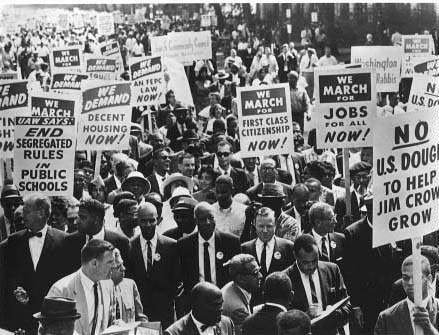
In 1963 an Organizing Manual No 2 was prepared and distributed as the official document for the August 28th March for Jobs and Freedom. It came out of the New York Office under the leadership of Bayard Rustin, Deputy Director for the event. This document identified the Ten Chairmen of the March. They were: Mathew Ahmann, Executive Director of the National Catholic Conference for Interracial Justice; James Farmer, National Director of the Congress of Racial Equality; Reverend Martin Luther King, Jr., John Lewis, Chairman of the Student Nonviolent Coordinating Committee; Rabbi Joachim Prinz, Chairman of the American Jewish Congress, A. Philip Randolph, President of the Negro American Labor Council, Walter Reuther, President of the United Automobile, Aerospace and Agricultural Implement Workers of American, AFL-CIO, and Chairman, Industrial Union Department, AFL-CIO; Roy Wilkins, Executive Director of the National Association for the Advancement of Colored People, and Whitney Young, Executive Director of the National Urban League.
The “Why We March” statement in the Manual was provided to make sure that each person understood the goals of the event. It stated that: “We march to redress old grievances and to help resolve an American crisis.” The statement said in part that the “crisis is born of the twin evils of racism and economic deprivation. They rob all people, Negro and white of dignity, self respect and freedom..”
It is also interesting how much the following statements from that document 50 years ago seems to apply to the U.S. Congress of the last five years. Notice what the manual said then: “Despite the current crisis, reactionary Republicans and Southern Democrats in Congress are still working to defeat effective civil rights legislation. They fight against the rights of all workers and minority groups… The Southern Democrats came to power by disfranchising the Negro. They know that as long as black workers are voteless, exploited, and under paid, the fight of the white workers for decent wages and working conditions will fail.”
There were Ten Demands stated in this Manual, four of which are still of significant importance to us today considering the recent decisions of the United States Supreme Court in its decision to gut the Voting Rights Act of 1965. These four demands were: (6) Authority for the Attorney General to institute injunctive suits when any constitutional aright is violated. (7) A massive federal program to train and place all unemployed workers–Negro and white–on meaningful and dignified jobs and wages; (8) A national minimum wage act that will give all Americans a decent standard of living.” How interesting that 50 years later we are again talking about a minimum wage increase, this time we are trying to get $10.00 as a national minimum wage. In 1963, the goal was $2.00 per hour.
In discussing who will march, the Manual stated that “All Americans of good will who will subscribe to the aims and purposes of the march; all Americans who demand an end to the twin evils of racism and economic degradation.”
There was also a schedule in Washington starting at 10:00 am as the time that all participants were requested to be at the Washington Monument grounds for a special program; The march itself was to began at 12:00 noon down Independence and Constitution Avenue to the Lincoln Memorial. The program itself began at 2:00 pm at the Lincoln Memorial. More will be said next week in Part III.


